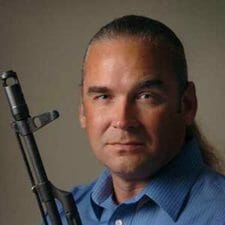
U.S.A. –-(AmmoLand.com)- Our friends at Ammoland Shooting Sports News have done incredible work exposing the crimes – actual crimes – NBC correspondent Vaughn Hillyard and his crew committed while producing the liberal network’s latest hit-piece on homemade firearms. I was asked to take a look at the story from a different perspective. What I found was simply unbelievable – the worst news story focused on firearms ever produced for a network news program.
To be clear, NBC’s “Inside look at the rising ‘ghost gun’ market in the U.S.” is without a doubt the most unethical, factually bankrupt hit-piece I have ever seen. There is not even a close second. Its badness is unrivaled, without peer.
Most gun owners don’t even realize that journalists have ethics they must follow, because when it comes to gotcha stories about guns, most journalists throw the ethics right out the window. Hillyard and his production crew were no different. They certainly didn’t let ethics or even facts get in the way of the biased story they wanted to tell.
Here are my major takeaways:
Hidden cameras
The Poynter Institute is a journalism think tank respected throughout the industry. Bob Steele is Poynter’s Scholar for Journalism Values. He wrote this about the use of hidden cameras: “Because they involve deception, hidden cameras should be our last choice for reporting a story. It is appropriate to consider their use on stories where we have ruled out all other alternatives for obtaining the same information. We must exhaust traditional reporting methods of interviewing, observing and researching documents and databases.”
Steele is not alone in his opinion. The Radio Television Digital News Association (RTDNA) describes itself as “the world’s largest professional organization devoted exclusively to broadcast and digital journalism.” The RTDNA honors the best of television news through its prestigious Edward R. Murrow Awards. The association has a strict set of guidelines on the use of hidden cameras. All of the following criteria must be met before a hidden camera can be deployed:
- When the information obtained is of profound importance. It must be of vital public interest, such as revealing great system failure at the top levels, or it must prevent profound harm to individuals.
- When all other alternatives for obtaining the same information have been exhausted.
- When the journalists involved are willing to disclose the nature of the deception and the reason for it.
- When the individuals involved and their news organization apply excellence, through outstanding craftsmanship as well as the commitment of time and funding needed to pursue the story fully.
- When the harm prevented by the information revealed through deception outweighs any harm caused by the act of deception.
- When the journalists involved have conducted a meaningful, collaborative, and deliberative decision-making process on the ethical and legal issues.
As you can see, none of these criteria were met – I doubt any were even considered – before Hillyard and his crew smuggled their hidden cameras into a Pennsylvania gun show.
Personally, I have never used a hidden camera or ever wanted one used. I believe people have a right to know when they are being filmed, especially if the footage is going to be used to their detriment – especially if it will be aired on a national news program.
Also, there was no reason to jump to the hidden camera, since the vendor selling the homemade firearm kits willingly submitted to an interview with Hillyard.
Biased statistics
Statistics themselves are ripe for manipulation by a biased journalist, but when biased statistics are used, the sin becomes even greater. For this story, Hillyard used stats provided by the Giffords anti-gun group. In other words, they got their anti-gun stats from an anti-gun group. How this made it through the normal vetting process, which most news stories undergo, indicates there was no vetting process. Hillyard’s “news” story was unvetted.
Staged photos
In the piece, there’s a still shot of an unfinished homemade handgun receiver laying on a sidewalk as if it was part of a crime scene. Staged photos are lies. They’re as bad as making up a quote. At a newspaper, they’re a fireable offense. If a photo must be staged to illustrate a point, they must be labeled as a “photo illustration.” To do otherwise is to lie to the viewers.
Biased experts
Hillyard never discloses to his viewers that one of the sources in his story, Attorney General Josh Shapiro, has a grudge against the homemade firearm vendor. Shapiro’s bias should have been disclosed or he should not have been used in the story. Nothing is more indicative of a reporter’s bias than stacking the deck with biased experts.
Selective editing
Raw video gets edited before it is published. That’s part of the normal production process. However, in this story, most of the vendor’s comments – especially the explanatory and exculpatory ones – made during a parking lot “ambush” interview were never published. News stories usually have two sides. To be fair, both sides should get to have their say. Hillyard and his crew were clearly afraid of the vendor’s comments, because they shot holes in their “ghost guns bad” theory, so the viewers never got to hear the whole truth. This is a huge red flag that the reporter was afraid of the truth.
Breaking the law
There are times when a journalist could ethically violate the law in order to get a story. However, it would have to be one hell of a story. Hillyard’s opus certainly doesn’t meet this standard. I asked an expert to review the story to determine whether laws were broken. Turns out they were, according to John “JC” Clark, cofounder of FFL Consultants. JC knows firearm law far better than I ever will.
“The Gun Control Act (GCA) permits an unlicensed individual to make a firearm for personal use, but not for sale or distribution. Although the law doesn’t explicitly prohibit a non-licensee from selling, giving away, or otherwise transferring a personally manufactured firearm, (i.e. ghost gun or homemade firearm,) to another non-licensee, it does stipulate that the original intent must have been for personal use. In addition, the GCA also restricts the transfer of handguns to an out-of-state resident and clearly states that it is not permitted as private party transfers require both individuals to reside in the same state.
Moving on to Pennsylvania law: To transfer an eligible firearm, more specifically handguns as required, both parties must accomplish the transfer through a Federal Firearms Licensee or a Sheriff’s Office so the transferee can undergo a background check.
Based on the scenario, it certainly doesn’t appear to be for “personal use.” Then you have the fact that the AG’s office manufactured firearms and are not a Federal Firearms Licensee and not a licensed manufacturer of firearms. (I also have issues with a public law enforcement agency participating with a private entity in this way, as there are most certainly conflict of interest issues that could result.) With regards to the referenced Philadelphia code, the statement referring to §10-2002 is accurate, however I believe there is currently a stay in place where enforcement of the referenced code is concerned, as the State of Pennsylvania (Commonwealth of Pennsylvania) has a preemption clause which clearly outlines that counties, municipalities or townships may not create restrictions on firearms that are not prohibited by the laws of the Commonwealth.”
In conclusion
By violating even the most basic journalism ethics, in addition to federal and state law, Hillyard and his production team also broke one of journalism’s cardinal rules: Rather than simply telling a story, they became part of the story. I hope those who were libeled, defamed, and portrayed in a false light by this “news” story seek competent counsel. NBC has deep pockets, after all, and as a community, we need to stop accepting this type of mistreatment.
It’s time we start fighting back.
This story is presented by the Second Amendment Foundation’s Investigative Journalism Project and wouldn’t be possible without you. Please click here to make a tax-deductible donation to support more pro-gun stories like this.
About Lee Williams
Lee Williams, who is also known as “The Gun Writer,” is the chief editor of the Second Amendment Foundation’s Investigative Journalism Project. Until recently, he was also an editor for a daily newspaper in Florida. Before becoming an editor, Lee was an investigative reporter at newspapers in three states and a U.S. Territory. Before becoming a journalist, he worked as a police officer. Before becoming a cop, Lee served in the Army. He’s earned more than a dozen national journalism awards as a reporter, and three medals of valor as a cop. Lee is an avid tactical shooter.

from https://ift.tt/ShZXHaF
via IFTTT

No comments:
Post a Comment